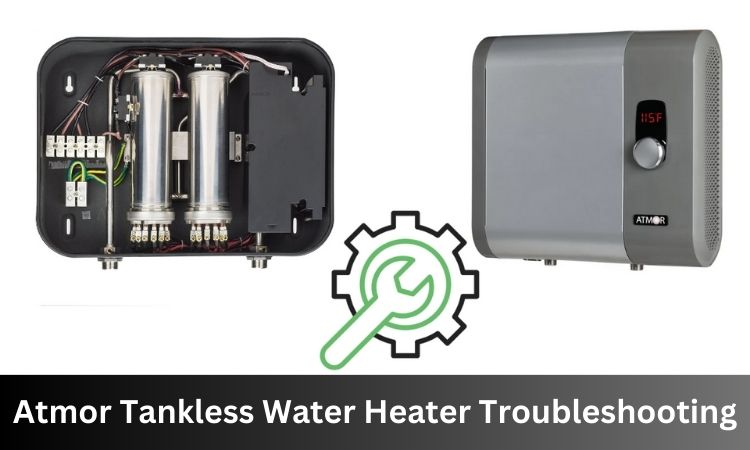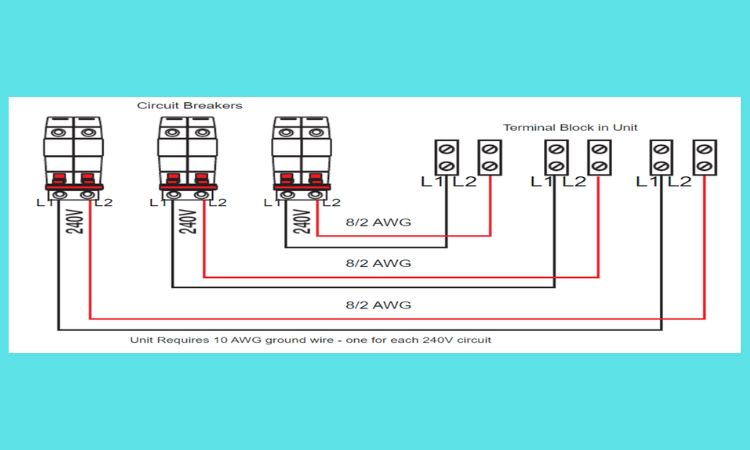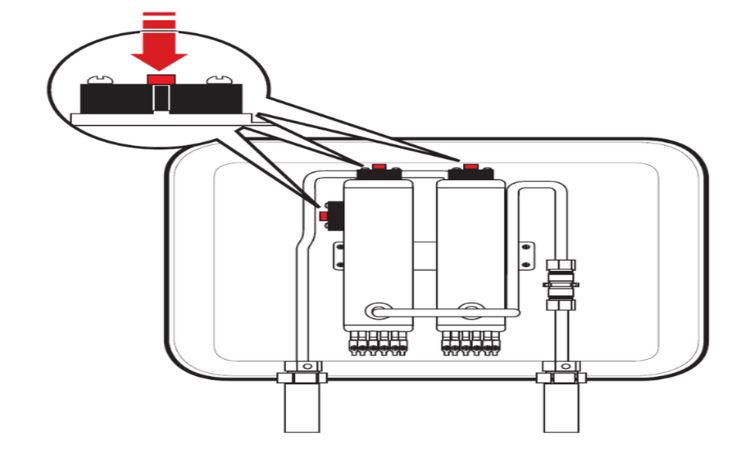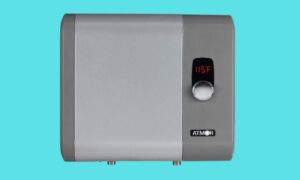You can’t expect to install a tankless water heater without ever encountering some problems along the way. Brands like Atmor are also bound to show some problems every now and then.
So, what includes Atmor tankless water heater troubleshooting?
Some common problems that you will need to troubleshoot in your Atmor tankless water heater are:
- The heater is not heating
- The water isn’t hot enough
- The water is too hot
- The heater keeps turning off
- The water temperature fluctuates.
I have years of experience repairing different Atmor tankless water heater models. And from my experience, I have seen that all these problems have some separate reasons which require particular solutions. For example, ensuring proper water flow rate and power or correctly installing the wiring.
In this article, I am going to talk about all those reasons and solutions in detail. So, keep reading!
Table of Contents

Atmor Tankless Water Heater Troubleshooting
Before driving into the proper details, let’s take a moment to map out the key points of this article. I’ve had the opportunity to troubleshoot various models of Atmor tankless water heaters, and fortunately, they all seem to share similar issues stemming from common root causes.
That means no matter which specific Atmor tankless water heater model you happen to be using, this comprehensive troubleshooting guide is designed to assist you. Those models can include the ThermoPro series, Thermopro 2 series, Thermo Boost series, or InLine series. These are the tankless water heater series of Atmor.
However, if you are a user of the Atmor tankless water heater ThermoPro or Thermopr 2 series, you might face an additional problem that is only common for these models. I haven’t encountered this problem in any other Atmor tankless water heater series. So, I am going to add this in another segment later.
General Atmor Tankless Water Heater Problems Troubleshooting
From my experience with troubleshooting the Atmor tankless water heaters, I have faced the below-mentioned problems. According to the owner’s manual of the Atmor tankless water heater, these are common problems as well.
Let’s get to the detailed discussion and see what causes a tankless water heater to stop working.
Problem 1: Atmor Tankless Water Heater Not Heating
At times, you may notice that your Atmor tankless water heater is not heating the water or stopped working which is its primary job. When you turn on a hot water tap or appliance, to your utmost disappointment, you will get only cold water.
Reasons:
There are several reasons why your ATmor tankless water heater is not heating. Here are those reasons.
Step 01: Absence of Power Supply: Without power, the heater can not turn on and the heating element in the unit can’t generate heat. As a result, you get no hot water at all.
Step 02: Insufficient Water Flow Rate: Atmor Tankless water heaters require a minimum water flow rate of 0.5 GPM to activate. If the water flowing through the heater is below this threshold, the unit may not kick into action. This low flow problem can cause the water heater to not heat water.
Step 03: Tripped Reset Button: The reset button on your Atmor tankless water heater is a safety feature and if this button is tripped, it shuts down the function of the water heater.
Step 04: Internal Component Malfunction: If there’s a malfunction in one of the internal components of your Atmor tankless water heater, it can disrupt the heating process. These components play crucial roles in heating the water and regulating the unit’s operations. When one of them malfunctions, it can prevent the heater from effectively heating the water. Atmor Instant water heaters can also stop working due to the internal component malfunction.
How To Fix It?
To fix this problem, you have to troubleshoot the following factors one by one.
i) Ensure proper power supply to the unit
Check that the heater is properly plugged in or that the circuit breakers to the water heater haven’t tripped. You also need to check if the breaker is in the On position or not. If not, turn the breaker to the On position. Ensure there are no loose connections in the power supply.
ii) Ensure sufficient water flow rate
Make sure the shut-off valve to the water inlet valve of the heater is fully open and not partially closed. Also, make sure the screen filter is clean enough for proper water flow. If your home water supply rate is less than 0.5 GPM, consult the omber and tell them to come up with a solution to increase the water supply rate.
iii) Reset the tripped Button
Locate the reset buttons on your heater and press them to reset the unit. The detailed process of resetting the heater is mentioned below in this article.
iv) Fix the internal component
If you suspect a malfunction in the internal components, it’s best to contact a qualified technician or the manufacturer’s customer support to have it fixed. Internal component issues require specialized knowledge and tools for diagnosis and repair.
If you attempt to fix them yourself may void the warranty or cause further damage. Fixing these should make the heater work again. And you can tell the heater is working properly when you get enough hot water.
However, if you are not getting hot water only on a particular faucet, as the kitchen sink and other faucets work well, that means there is an issue with the faucet. In that case, you have to replace the particular faucet.
After fixing the issue, try to use the heater and see if it works. Now, you might be wondering, how to turn on and off the Atmor tankless water heater.
You don’t have to do anything extra to turn on the Atmore tankless water heater. These tankless water heaters provide instant hot water on demand.
When you turn on a hot water faucet, the Atmor system senses the need for hot water through a flow sensor and turns on strong heating elements. It keeps an eye on how fast water flows and checks the temperature of the incoming and outgoing water.
All this information goes to the system’s control, which figures out how much power the heating elements need to make the water as warm as you like. Obviously, to ensure this smooth operation, you need to provide proper power and water flow rate.
Problem 2: Atmor Tankless Water Heater Not Enough Hot Water
On certain occasions, you may experience not the water not hot enough from your Atmor tankless water heater. It means that while the heater does produce some hot water, it is still lukewarm and uncomfortable to use.
Reasons:
Step 01: Low-temperature setting: When the temperature setting on your Atmor tankless water heater is set too low, the heating element doesn’t generate enough heat to reach the desired hot water temperature. As a result, the water that comes out is lukewarm and not hot enough. Especially, in cold weather, you need to adjust the temperature a little high. Otherwise, you won’t get enough hot water.
Step 02: High water flow rate: If the water flows through the heater at a very high rate, the heating element may not have enough time to sufficiently heat the water. This can result in the water remaining lukewarm as it passes through the heater.
Step 03: Low voltage: Atmor tankless water heaters require 240 volts to run properly. Low voltage in the electrical supply to the tankless water heater can hinder the heating element’s ability to generate adequate heat.
Step 04: Low water pressure: Low water pressure can restrict the flow of water through the heater, reducing the amount of hot water produced. Atmor tankless water heaters require at least 0.7 psi or 0.5 BAR to heat the water properly.
Step 05: Too much mixing of cold water: If there’s an excessive mix of cold water with the hot water at the fixture, it dilutes the hot water, making it lukewarm. This happens when you don’t properly balance the hot water and cold water faucet.
Step 06: Step 06: Long pipe thermal loss: When hot water has to travel through long pipes from the heater to the faucet or appliance, it can lose heat along the way. The result is that by the time the water reaches the point of use, it may have cooled down significantly, causing it to be lukewarm and not staying hot.
Step 07: Crossed wiring: In some cases, crossed wiring or incorrect electrical connections can disrupt the heater’s ability to function optimally. This may lead to inadequate heating and lukewarm water as a result. If you have a newly installed heater that is showing this problem, this can be the reason.
How To Fix It?
If you want to fix this problem and get properly heated water, here are the things you need to do.
i) Adjust the Temperature
Adjust the temperature setting on your Atmor tankless water heater to a higher temperature, preferably between 120°F (49°C) and 140°F (60°C), depending on your preference. Be cautious not to set it too high to avoid scalding.
ii) Reduce the Flow rate
Reduce the flow rate of hot water by partially closing the hot water tap. This allows the water more time to heat up as it passes through the heater, ensuring it reaches the desired hot temperature.
iii) Ensure Proper Voltage
Contact an electrician to inspect your electrical supply and ensure it meets the voltage requirements of your Atmor tankless water heater. If necessary, they can make any necessary electrical adjustments or repairs.
iv) Increase Water Pressure
Improve water pressure by making sure that the shut-off valve is opened fully. Salsos make sure no debris or dirt is stuck on the shut-off valve.
v) Don’t Mix Excessive Cold Water
Balance the cold water and hot water mixture properly. With a tankless water heater, you don’t typically need to mix as much cold water as you would with a regular water heater. This is because tankless heaters heat the water to a higher temperature right at the source.
Also, some faucets have a safety feature called anti-scald, which mixes in cold water to prevent hot water from being too hot. You can usually adjust these faucets to use less cold water and get hotter water if you prefer.
vi) Adjust The Temperature For Distant Use
When hot water travels from the heater to your faucet through the pipes, it can lose some of its heat, especially if the pipes are long or cold. This is a normal thing that happens. If you want your water to be hotter, you can adjust the temperature setting on your water heater to make up for this heat loss.
vii) Ensure Proper Wiring
If you suspect crossed wiring or incorrect electrical connections, consult a qualified technician or electrician to diagnose and correct the wiring issues. Ensure that the electrical connections are properly configured according to the manufacturer’s guidelines.
The following wiring map might help with the process.

Problem 3: Atmor Tankless Water Heater Water Too Hot
There might be events when the water coming from your Atmor tankless water heater becomes excessively hot. This can create discomfort and even cause a safety hazard, especially if the hot water scalds your skin or is too hot for everyday use.
Reasons:
If you are wondering why your Atmor tankless water heater is producing extra hot water, you should consider the following reasons.
Step 01: Too slow outlet water flow rate: When the outlet water flow rate is too slow, the water spends more time inside the heating chamber of the tankless water heater. As a result, it has a longer duration to heat up, which can lead to excessively high water temperatures.
Step 02: Too high-temperature setting: If the temperature setting on your Atmor tankless water heater is set too high, the heating element will generate hotter water than what is safe or comfortable.
Step 03: Internal component failure: Internal components in the tankless water heater are responsible for regulating the water temperature. If one of these components fails or malfunctions, it can disrupt the heater’s ability to control the water temperature accurately. This can lead to the production of excessively hot water.
How To Fix It?
Here are the fixes you can try to get rid of excessively hot water from your Atmor tankless water heater.
Increase the Flow Rate
One way to mitigate excessively hot water is to increase the water flow rate. Open the hot water tap wider to allow more water to flow through the heater. This should help reduce the amount of time water spends in the heating chamber, resulting in cooler water.
You can mix the hot water with the cold water by opening both the faucets together.
Adjust the Temperature Setting
Locate the temperature control setting on your Atmor tankless water heater and lower it to a safer and more comfortable level. It’s recommended to set the temperature to a range between 120°F (49°C) and 140°F (60°C) to prevent scalding and ensure usability.
Have the Internal Component Fix
If none of the above-mentioned suggestions don’t work, you most probably have an internal component failure in your water heater. In that case. You must consult a professional. According to the ThermoPro 2 series manual, it is best to directly call the manufacturer for assistance in this case.
Problem 4: Atmor Tankless Water Heater Keeps Turning Off During Usage
Occasionally, your Atmor tankless water heater may show the frustrating behavior of repeatedly shutting off while you’re using hot water. Sometimes, it shuts off only one time. Sometimes the heater keeps doing it again and again.
Reasons:
This problem also has multiple reasons which are mentioned below.
Step 01: Power outage: During a power outage, the Atmor tankless water heater loses its power supply. Without electricity, it cannot function, and it may shut off automatically.
Step 02: Tripper circuit breaker: A tripped circuit breaker is a safety mechanism designed to protect electrical circuits from overloads or faults. If the circuit breaker that supplies power to your tankless water heater trips, it cuts off the electricity, causing the heater to shut down. This can occur due to electrical issues or excessive demand on the circuit.
Step 03: Faulty wiring: Faulty or damaged electrical wiring can disrupt the flow of electricity to the tankless water heater. If there are wiring issues, including loose connections or damaged wires, the heater can experience interruptions in the power supply. Which will lead to repeated shutdowns of the heater during usage.
How To Fix It?
Here are the suggestions for this problem you can try implementing.
i) Wait For the Power To Return
If the tankless water heater shuts off due to a power outage, there’s not much you can do to prevent it, as it relies on electricity to operate. To mitigate such situations, consider installing a backup power source, like a generator or a battery backup system, to ensure uninterrupted hot water during power outages.
ii) Reset the Circuit Breaker
Locate the circuit breaker that supplies power to your tankless water heater. If it has tripped, reset it by switching it off and then back on. If it continues to trip frequently, consult an electrician to investigate and address any electrical issues that might be causing the overloads.
iii) Check the Wirings
Inspect the wiring leading to your tankless water heater. Look for loose or damaged wires, exposed wiring, or other visible issues. If you find any problems, it’s crucial to have a qualified electrician repair or replace the faulty wiring to ensure a stable and safe electrical connection for your heater.
Problem 5: Atmor Tankless Water Heater Stops Flowing Water
In certain situations, your Atmor tankless water heater may stop delivering any hot water when you open a faucet or turn on a shower.
Reasons:
Here are the reasons for this particular problem.
Step 01: Clogged water pipes or hoses: When the water pipes or hoses leading to or from the tankless water heater become clogged, it restricts the flow of water. As a result, the heater may stop delivering hot water because it cannot receive a sufficient supply of water to heat. These clogs can be caused by mineral deposits, debris, or sediment buildup in the pipes or hoses.
Step 02: Absence of water supply: If there is no water supply reaching the tankless water heater, it cannot function. This absence of water supply may be due to issues such as a closed water shut-off valve, a water supply line blockage, or a disruption in the water source. In such cases, the heater stops delivering hot water because there is no water to heat.
How To Fix It?
To fix the lack of water flowing problem. Here are the solutions you can try.
Clean the Clogged Pipes
You have to check and clean the pipes to or from the water heater. Here’s a brief guideline of the process.
Step 1: First, turn off the water supply to the tankless water heater.
Step 2: After that, disconnect and inspect the water pipes or hoses leading to and from the heater one by one.
Step 3: If you find any clogs, mineral deposits, debris, or sediment buildup, clean or remove them as needed. You can use a pipe brush or a descaling solution for this purpose.
Step 4: Once the cleaning is done, reconnect the pipes or hoses securely.
Step 5: Turn the water supply back on and check for proper water flow and hot water delivery from the heater.
Ensure Proper Water Supply
You have to ensure proper water supply to the water heater and from the water heater. To ensure this, follow the activities below.
- Check and make sure that the water shut-off valve leading to the tankless water heater is fully open.
- Check for any water supply disruptions in your area, such as water main issues or maintenance work. If there is a widespread water supply problem, contact your water utility provider for information and updates.
- If you suspect a more significant issue with the water supply, such as a frozen pipe, consult a plumber or a professional to diagnose and resolve the problem.
Problem 6: Atmor Tankless Water Heater Fluctuating Water Temperature
At times, you can experience inconsistent water temperature from your Atmor tankless water heater. The hot water may suddenly turn cold or vice versa while you’re in the middle of using it. Such temperature fluctuations can make tasks like showering or washing dishes uncomfortable and challenging to manage
Reasons:
A sudden drop in water pressure is the only reason behind this problem. For ATmor tankless water heater. When there is a rapid and significant decrease in water pressure in the supply line, it can disrupt the flow of water to the tankless water heater.
How To Fix It?
First, identify the main water supply valve that feeds water into your home or to the specific appliance where the tankless water heater is installed. Carefully open this valve fully to maximize the flow of water into your plumbing system.
Ensure that the valve is fully turned in the counterclockwise direction to allow the highest possible water flow rate. By increasing the flow rate at the source, you can help maintain the necessary pressure and flow of water to the tankless water heater, preventing interruptions in hot water delivery.
Additional Troubleshooting For Atmor Tankless Water Heater ThermoPro Series
If you are a user of the ATmor tankless water heater TheroPro or Thermopro 2 series, there is an additional problem you often might face. Let’s discuss this problem in detail.
Problem: Atmor Tankless Water Heater Not Turning On
Occasionally, your Atmor tankless water heater may refuse to power up or respond when you need hot water. This makes the unit temporarily non-functional. Also in this situation, you will notice that the display monitor in your water heater is not lighting up.
Reasons:
There are several reasons why your ThermoPro or ThermoPro 2 series Atmor water heater is not turning on. Here are those.
Step 01: Circuit Breaker Got Tripped: A tripped circuit breaker interrupts the power supply to the water heater. As a result, the water heater doesn’t turn on.
Step 02: Breakers Got Turned Off: If the breakers are switched off, the heater lacks the electrical connection needed to function.
Step 03: Faulty Breaker: A faulty breaker or wiring can disrupt the electrical flow. This prevents the heater from turning on.
Step 04: Closed Shut-Off Valve: A closed shut-off valve restricts water flow to the heater. As a result, the heater doesn’t get a proper water supply to turn on and activate.
Step 05: Dirty Filter Screen: A dirty filter screen can impede water intake. Similar to water to a closed shut-off valve, it causes the heater to shut down.
Step 06: Low Water Supply Rate: An insufficient water supply rate can trigger safety mechanisms that prevent the heater from operating.
Step 07: Faulty Wiring: If the wiring of the heater was faulty during the installation, it causes the heater not to turn on.
How To Fix It?
If you want to turn On your Atmore water heater without any problem, follow the troubleshooting steps given below.
i) Check the Circuit Breaker
First, locate the circuit breaker panel in your home and check if the breakers for the water heater have tripped to the “off” position. If one of them has, reset it by switching it back to the “on” position.
ii) Ensure Breakers Are On
Make sure that all breakers related to your water heater are switched on. This includes both the main electrical panel breaker and any secondary breakers dedicated to the water heater. Turning them on will ensure proper electrical connection for the heater to function.
iii) Examine for Faulty Breaker or Wiring
Inspect the breaker and wiring connected to the water heater. Look for any signs of damage or wear. If you notice any issues, such as frayed wires or a malfunctioning breaker, you must replace them to restore the electrical flow required for the heater to work.
iv) Check the Shut-Off Valve
Locate the shut-off valve that controls the water supply to the heater. It is located in the inlet unit. Ensure the shut-off valve is fully open.
v) Clean the Filter Screen
Clean the filter screen to the inlet unit shut-off valve. This process requires removing the valve. Before performing this cleaning process, you must turn off the power to the heater to ensure safety.
vi) Verify the Water Supply Rate
Ensure that the water supply rate to the heater meets the manufacturer’s specifications. For Atmor tankless water heaters, it is 0.5 GPM. If the supply rate is low, you may need to address water pressure or flow issues in your plumbing system.
vii) Address Faulty Wiring
If the wiring of the heater was faulty during installation, it’s crucial to consult a professional electrician or technician. They can diagnose and correct any wiring issues to ensure the heater receives the proper electrical connections required for it to turn on and function correctly.
How To Reset Atmor Tankless Water Heater?
If your Atmor tankless water heater has tripped its reset button due to issues like overheating or electrical problems, you can reset it to get hot water again. Here’s a straightforward guide to resetting the Atmor Tankless water heater.
Step 1: Before starting, make sure the power supply to your water heater is off to prevent electrical accidents.
Step 2: To locate the reset buttons, you have to remove the front cover of your water heater. So, remove the cover by loosening its bolt with an adjustable wrench.
Step 3: There should be three reset buttons. Locate all of the reset buttons of the Atmor tankless water heater. Here’s a picture of those buttons for a better understanding.

Step 4: Now, it’s time for rest. Start by pressing the red reset button on the side. Then, press the two red reset buttons on the top of the heating elements one by one. Listen for a “click” sound, indicating a successful reset.
Step 5: Put the cover back in place and secure it tightly with the bolts.
Step 6: Finally, restore power to the heater and turn it back on.
This is how you reset the Atmor tankless water heater.
Atmor Tankless Water Heater Maintenance
To ensure your Atmor tankless water heater performs at its best and you are facing these problems less, you must maintain and care for the water heater on a regular basis. Here’s a maintenance guideline for your Atmor tankless water heater that will say how to service a tankless hot water heater.
01. Regular Inspections and Tests
Your water heater needs some minimal maintenance. Periodically, check it for any signs of damage or problems.
If you notice any damage, cracks, leaks, or weaknesses, take action immediately to fix them. But be careful not to over-tighten any connections as this could harm the unit internally.
02. Dealing with Scale Buildup
Water heated at higher temperatures can cause scale buildup inside the heater more quickly. For this reason, you should consider installing manual shut-off or maintenance valves on the inlet and outlet of your water heater. These valves will help you flush the unit with a descaling solution when needed.
The Atmore manufacturer recommends routine maintenance once a year. If your water supply has a lot of minerals (hard water), you should do this every six months.
03. Cleaning the Inlet Pre-Filter
Every six months, clean the pre-filter on the inlet side where water enters the heater. A gentle wash will remove any debris.
04. Dealing with Air in the Plumbing
Whenever you perform maintenance on your water heater or plumbing system that might introduce air into the pipes, follow these steps:
- First, turn off the water heater.
- After that, purge the air from the plumbing lines.
- Finally, turn on the water heater again.
Failing to do this could harm the heating element and void your warranty.
If you follow these simple routine maintenance, your Atmor tankless water heater will remain in good condition for a longer time.
FAQs:
What is the most common issue with tankless water heaters?
The most common issue with tankless water heaters is low water pressure. This can result from mineral buildup, clogs, or inadequate supply flow. This leads to reduced performance and temperature fluctuations. Sometimes, the heater doesn’t even activate due to this.
What kind of maintenance does a tankless water heater need?
Tankless water heaters require periodic maintenance, including descaling to remove mineral buildup, cleaning filters, inspecting electrical connections, and testing safety features. These are the regular maintenance that should be done every 6-12 months. Regular checks ensure efficient operation and prolong the unit’s lifespan.
How many hours a day does a tankless water heater run?
On average, a tankless water heater runs around 3 hours a day. However, this run depends on the age and condition of the heater. If your heater is comparatively new, it runs 1-2 hours. If the heater is older, it can even run for five or more hours a day.
Do tankless water heaters use a lot of electricity?
Yes, tankless water heaters use a lot of electricity which is on average 17% of your home’s total consumption of electricity. However, the consumption is still less than traditional water heaters or boilers with tanks.
Conclusion:
That’s all about the Atmor tankless water heater troubleshooting guide. I really hope this article covers all the problems you couple ever face with your Atmor tankless water heater. Also, I tried to cover all the solutions as well.
Thanks for reading this. Now it’s time to say goodbye. Wish you all the best.
If you are interested, you can also read our article on the iHeat Tankless Water Heater Troubleshooting guide as well. Because more or less, all the heaters face similar problems and you may have something in common.

